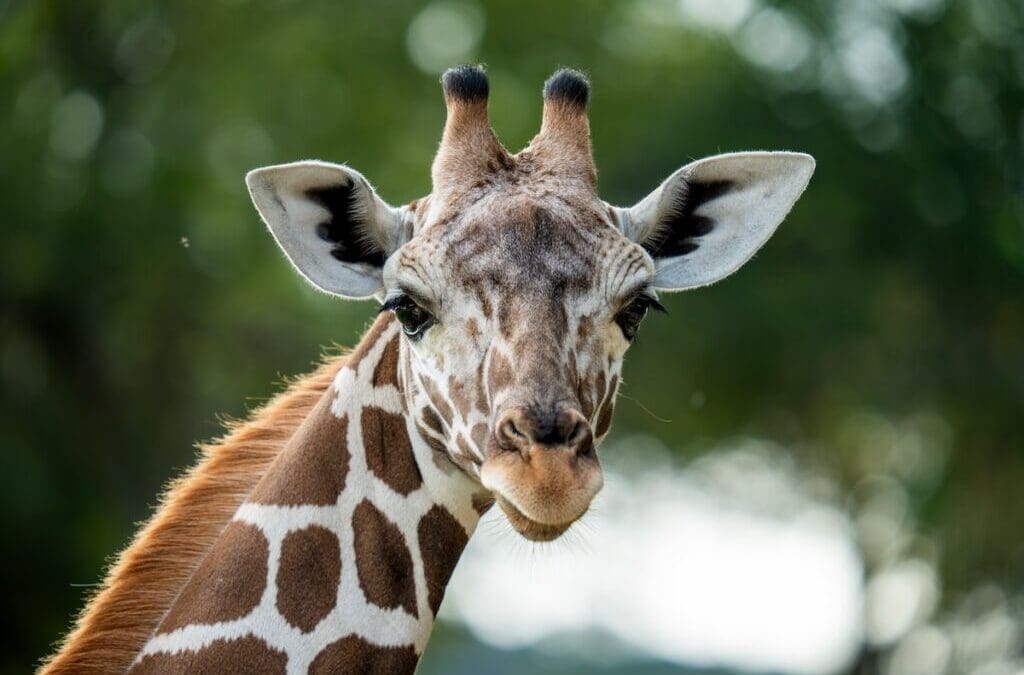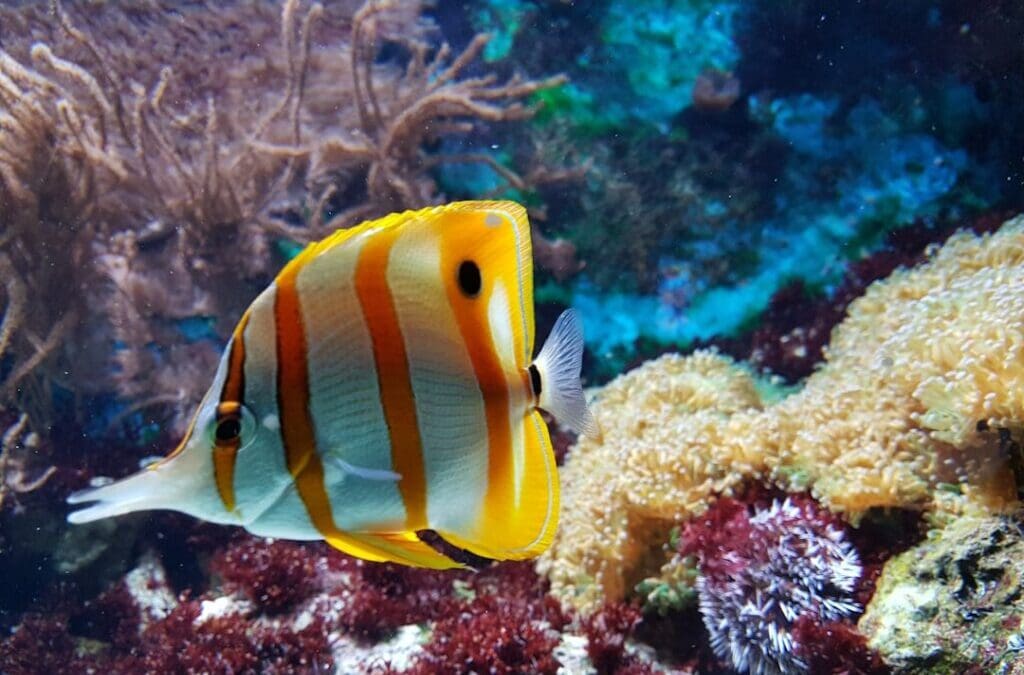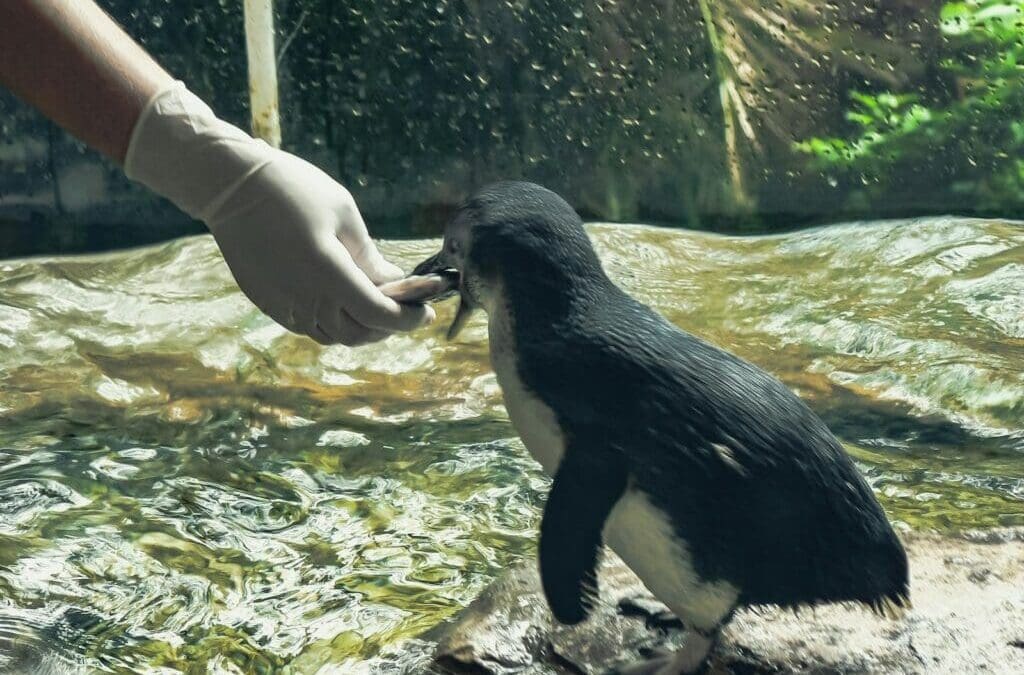
by pixeladmin7 | Dec 5, 2024 | Baby Animals, General, san antonio zoo
The San Antonio Zoo is proud to announce the arrival of Waffles, a young and inquisitive Reticulated giraffe, who officially joined the zoo’s giraffe herd on November 29. Born on March 4, 2023, at Fossil Rim Wildlife Center, Waffles is already making waves as a key addition to the zoo’s conservation efforts under the Species Survival Plan (SSP), a program led by the Association of Zoos & Aquariums (AZA).
Supporting Conservation for Giraffes
Giraffes face growing threats in the wild, with their populations seeing alarming declines. The International Union for Conservation of Nature listed some subspecies as critically endangered in 2018, and recent proposals by the U.S. Fish and Wildlife Service aim to grant certain giraffe subspecies increased protections under the Endangered Species Act. Waffles’ arrival is a step forward in preserving genetically diverse populations and ensuring the future of these majestic creatures.
An Immersive Experience for Guests
Guests can now visit Waffles at the Naylor Savanna, the zoo’s newly renovated giraffe habitat featuring expansive viewing opportunities and floor-to-ceiling windows for an up-close look into the giraffe barn. This state-of-the-art habitat not only enhances animal care but also creates unforgettable encounters for visitors.
“Waffles’ arrival is a moment for celebration at the zoo and the next step in building our herd for future breeding,” said Tim Morrow, President & CEO of San Antonio Zoo. “She represents our continued commitment to conservation while offering a special opportunity for the community to get closer to one of the most iconic species on Earth. We can’t wait for guests to come out and welcome her into her new home.”
Unique Experiences Await
Waffles isn’t the only star of the show. Longnecks Bar & Grill, located near the Naylor Savanna, is celebrating her arrival with exclusive waffle flights available through December 31. Guests can enjoy this special treat while taking in breathtaking views of the habitat.
For an even more immersive experience, book a stay at Spekboom Lodge, the zoo’s new overnight suite. Located in the Naylor Savanna, the lodge lets guests sleep alongside giraffes, zebras, and other African wildlife. A portion of each booking supports the Giraffe Conservation Foundation, the only global organization dedicated to giraffe conservation.
Plan Your Visit Today
Explore more about the San Antonio Zoo and its efforts by visiting Zoos.com’s San Antonio Zoo page. Ready to meet Waffles? Get your tickets now and enjoy exclusive deals on admission!
Join us in welcoming Waffles and supporting vital conservation work at the San Antonio Zoo!
Images courtesy of the San Antonio Zoo

by pixeladmin7 | Nov 15, 2024 | aquarium membership, aquariums, General, membership benefits, Memberships, zoo membership, zoos
How Zoo Memberships Can Save You Money All Year
Imagine a world where exciting adventures with wild animals and fascinating sea creatures await you at every turn, and all it takes is a short trip to your local zoo or aquarium! With a zoo membership, this world can be yours without breaking the bank. These all-access passes are more than just a ticket to see amazing animals; they’re a passport to incredible savings and unforgettable family fun all year long. Why just visit once when you can embark on a fresh expedition each season? Whether you’re exploring new exhibits, attending exclusive member events, or simply enjoying a spontaneous day of animal discovery, a zoo membership offers endless opportunities for adventure and savings. Let’s dive into how these memberships can unlock a treasure trove of benefits for you and your family!
Zoo Membership Benefits
Get ready to unlock the gates to a world of wonders with a zoo membership! This magical key offers more than just savings—it opens doors to exclusive experiences, opportunities to learn, and a chance to make every visit unforgettable. Let’s dive into the treasure trove of benefits that await members!
Exclusive Access and Member Events
Picture this: strolling through your favorite zoo before it opens or after it closes, with the quiet serenade of nature as your backdrop. Zoo memberships often provide early or late entrance opportunities that allow you to experience the zoo in a whole new light. Member-exclusive events, like behind-the-scenes tours or animal meet-and-greets, let you peek into the fascinating lives of the animals you adore. Plus, have you ever thought about attending a members-only night, where you can enjoy special programs and entertainment with your family under the stars? Now you know!
Discounts on Food and Merchandise
Who doesn’t love a good discount while enjoying a day out? As a zoo member, savor delicious meals at a reduced price at on-site cafes and food carts. Why stop there? Your membership also extends to the gift shop, where you can find adorable plush animals, eco-friendly souvenirs, and educational books to thrill the little ones. With discounts on food and merchandise, you can treat your family and make memories without emptying your pockets.
Educational and Conservation Opportunities
Ever wondered what you can do to make a difference? Zoo memberships are a gateway to learning about conservation efforts and how you can contribute. Members often receive access to special educational programs and workshops, perfect for curious minds eager to explore the natural world. Participate in conservation campaigns and activities that might just inspire your next great adventure or environmental project. By being a member, you’re supporting vital conservation work, making every visit meaningful and impactful.
Financial Advantages of Zoo Memberships
While the thrills and learning opportunities are abundant, the financial benefits of a zoo membership can’t be overlooked! Let’s crunch some numbers and discover how you can stretch your dollars further.
Unlimited Visits and Cost Per Visit
Say goodbye to the restrictions of single-day tickets! Zoo memberships often include unlimited visits for an entire year. You’re free to visit your animal friends as often as your heart desires, whether it’s a quick afternoon getaway or a full-day exploration. Divide the cost of membership by the number of visits, and you’ll marvel at the value. Each exploration becomes a priceless opportunity, making every penny count!
Special Rates for Families and Groups
Zoo days are better with company, and memberships offer fantastic options for family and group visits. Many zoos provide family packages that make it affordable for everyone, including two adults and all the little explorers they can handle. Group memberships can mean even more savings, allowing you and your extended family or group of friends to create memories together. Check for specific packages and see how easy it is to keep the crew entertained without breaking the bank.
Seasonal Promotions and Partnership Discounts
Here’s a little secret: zoo memberships often come with seasonal promotions! From summer savings to holiday specials, keep an eye out for discounts that make joining even sweeter. But wait, there’s more! Many zoos partner with local attractions, allowing members to enjoy discounted or reciprocal entry to other venues like aquariums, botanical gardens, or museums. Your membership opens doors to even more adventures, broadening your family’s fun-filled calendar without adding extra costs.
So there you have it! The adventure awaits, and the savings are real. Whether you’re a local wildlife lover or a frequent explorer, a zoo membership is a ticket to endless excitement and economical fun. Are you ready to join the zoo family and elevate your wild experiences? Go ahead, and take the plunge into a year of adventures!
Tips for Maximizing Your Zoo Membership Value
Hey there, fellow wildlife enthusiasts! If you’re ready to make the most out of your zoo membership, you’ve come to the right place. It’s not just about having unlimited entry to your favorite zoo or aquarium; it’s about creating unforgettable experiences and getting more bang for your buck!
Plan Your Visits
Firstly, planning is key. Take a look at your zoo’s calendar and mark down special events, like wildlife talks and member-exclusive previews. Some zoos offer after-dark adventures or sunrise safaris – perfect for those who crave a magical experience beyond the standard zoo day.
Attend Member-Only Events
Make sure you carve out time for member-only events. You’ll not only enjoy smaller crowds but often have access to unique activities that aren’t available to general visitors. Imagine attending a penguin parade or a private animal feeding session! These events can offer once-in-a-lifetime experiences that elevate your membership to more than just regular entry.
Utilize Discounts and Perks
Did you know your membership often includes amazing discounts and perks? Check for discounts at gift shops, cafes, and even on educational programs or zoo camps for the kids. Some memberships even provide reciprocal access to other zoos and aquariums, so your adventures can extend beyond your local habitat. Consider compiling a list of partner locations and plan a wild road trip!
Stay Informed and Engaged
Lastly, stay connected! Make sure you’re signed up to receive newsletters or follow social media channels for any updates or surprise perks. This ensures you never miss out on events and opportunities to engage with the community. The more informed you are, the more you can make your membership count.
Your zoo membership is more than just a pass – it’s a passport to adventure. So, grab your explorer hat, pack your curiosity, and make every visit an epic journey into the wild!
Joining an accredited zoo or aquarium membership program is like opening a treasure chest of endless adventures and savings right at your fingertips! Imagine your family exploring the vibrant habitats of playful otters or majestic elephants without a second thought about ticket costs. With these memberships, you’re not just investing in unlimited visits; you’re supporting wildlife conservation and educational programs that enrich millions. So why wait? Dive into a world of wonders today and let your family’s journey with wildlife begin!

by pixeladmin7 | Apr 29, 2024 | Educational Resources, Fun Zoo Activities & Crafts, General
Image by Gerd Altmann from Pixabay
The Ultimate Animal Alphabet Adventure for Kids
Exploring the animal kingdom through the alphabet is a delightful way for children to combine learning letters with a fascination for wildlife. As little ones journey from A to Z, they encounter a world of animals, each one associated with a different letter, enhancing both their alphabetic understanding and their knowledge of animal classification. Visits to the zoo become interactive lessons where each exhibit offers an exciting opportunity to identify creatures and match them to the corresponding letter of the alphabet.
Incorporated into preschool, kindergarten, and homeschool curriculums, an alphabet guide of animals makes for an educational adventure. It’s more than just memorizing the order of letters; it’s about bringing each character to life with an example from the natural world. As a practical educational tool, such a guide serves to entice curiosity in young minds while reinforcing letter recognition in a fun and engaging manner.
The joy of learning is greatly amplified when children are given the chance to relate abstract concepts like letters with real-world examples, like animals at the zoo. This method supports an interactive mode of education where kids can touch, hear, and even smell the subjects of their lessons, solidifying the connection between the academic and the tangible. It paves the way for a deeper understanding and a love for learning that extends beyond the classroom.
Exploring the Alphabet with Zoo Animals
Learning the alphabet is a crucial step for kids, and pairing each letter with a lovable zoo animal can make this process both engaging and educational. By associating letters with animals, children can improve their letter recognition skills and acquire new knowledge about the animal kingdom.
Letter Recognition and Animal Names
Educators and parents leverage the intrigue that zoo animals inspire to teach the letters of the alphabet. From A for Alligator to Z for Zebra, each letter is paired with an animal, blending phonics and fun. Color by letter worksheets further enhance this learning experience, allowing kids to associate letters with colors and animals in a creative way.
A: Alligator
B: Bear
C: Cat
D: Dog
E: Elephant
F: Flamingo
… and so on, through the alphabet.
Using such educational tools helps solidify letter recognition and lays the groundwork for early reading skills. Children delight in shouting out the names of zoo animals as they learn their ABCs, turning a reading exercise into an exciting game.
Fun Facts About Zoo Animals from A to Z
Each animal in the alphabet brings an opportunity to share fun facts that capture a child’s imagination. For example, children learn that alligators have been around since the age of the dinosaurs, bears have an excellent sense of smell, and giraffes have long necks that allow them to reach the highest leaves.
Giraffe: The tallest mammal on Earth.
Horse: Known for their speed and strength.
Iguana: A lizard with a row of spines along its back.
Jellyfish: No brain or heart, but can still sting!
Kangaroo: Hops on powerful hind legs and carries babies in a pouch.
Lemur: Has big, expressive eyes and a long, striped tail.
In sharing these facts, children’s natural curiosity is spiked, and the learning experience extends beyond just the alphabet to also include insights into the animal’s lifestyles and habitats. Such a method ensures that the educational journey is as thrilling as a day at the zoo, helping kids remember not only the letters but also the distinctive features of each zoo animal.
Creative Learning Activities
Incorporating crafts and coloring, alongside engaging literacy centers, can greatly enhance children’s learning about zoo animals. These activities are designed to be both informative and enjoyable for preschoolers, kindergarteners, and homeschool groups.
Crafts and Coloring with Zoo Themes
Using zoo color by letter worksheets, educators can introduce preschoolers to both the vibrant world of colors and the fundamentals of letter recognition. Simple crafts, such as making zoo animal masks from cardstock or creating animal figures from recyclable materials, can stimulate creativity and can be laminated for durability. Black and white coloring sheets not only entertain but also help children practice fine motor skills as they stay within the lines.
Materials needed for crafts:
Cardstock
Color pencils/Crayons
Laminating sheets
Suggested activities:
Zoo Animal Masks
Zoo Themed Coloring Sheets
Engaging Literacy Centers
For children in a classroom or homeschool setting, literacy centers that focus on zoo animals can tie together reading, phonics, and the excitement of learning new words. By using puzzles featuring different zoo animals, educators can facilitate both phonics practice and letter recognition in an engaging way. Kindergarteners can match animal pictures to their corresponding names, turning a simple matching game into a reading exercise.
Components of literacy centers:
Puzzles with animal images and names
Zoo animal picture cards with names
Activities to reinforce skills:
Animal Name Matching
Phonics Games with Zoo Animals
Integrating Zoo Adventures in Education
Zoo adventures can be a fundamental component of educational curriculum, providing interactive and engaging learning experiences. They merge the thrill of encountering animals with structured lessons that reinforce literacy and comprehension for children at different developmental stages, from preschool to kindergarten.
Interactive Zoo Animal Lessons
Incorporating zoo-themed videos into the classroom can instigate children’s curiosity about the animal kingdom. The Alphabet Zoo Adventure uses the allure of animals to teach the alphabet, turning a routine reading lesson into a lively zoo journey. Utilizing such resources encourages active learning and participation among children, making it a valuable asset for educators.
For Preschoolers:
Animal Sounds: Match letters with the corresponding animal sounds.
Animal Movements: Introduce physical activity by mimicking animal movements.
For Kindergarteners:
Habitat Discussion: Link animals to their habitats and foster environmental awareness.
Conservation Talk: Engage in simple dialogues about protecting animal species.
Zoo and Animal Books for Kids
Books like “Sesame Street: Elmo and Zoe’s A-to-Zoo Adventure” invite young readers to explore alphabets within the context of their favorite furry characters’ zoo experience. Such tailor-made zoo and animal books for kids effectively bridge reading fundamentals with their innate interest in animals, enhancing their educational journey.
Book Suggestions:
Zoo-phonics Parent Kit: Enable parents to participate in their child’s literacy development.
Alphabet Zoo Adventure: A to Z Animal Names!: Introduce toddlers to letters and animals through engaging illustrations and stories.
Introducing children to the wonders of the animal kingdom through interactive lessons and reading supports the educational focus of early childhood learning environments. These resources not only align with educational standards for reading and literacy but also foster a love for learning and a greater appreciation of wildlife.

by pixeladmin7 | Apr 22, 2024 | General, Zoo Management & Operations
Photo by K. Mitch Hodge on Unsplash
Zoo Researchers’ Daily Grind – Unveiling the Dedicated Wildlife Guardians
Visiting a zoo offers a glimpse into the lives of animals from around the globe, but the true heartbeat of these conservation centers lies in the day-to-day endeavors of zoo researchers. These dedicated scientists engage in a variety of crucial tasks that often go unnoticed by the public. From analyzing animal behavior to conducting vital conservation efforts, their work is essential in enhancing our understanding of wildlife and ensuring the health and well-being of zoo inhabitants.
The daily grind for these researchers involves more than just observing animals. It’s a complex routine that intertwines care, science, and education. They may start their mornings collecting samples for study, such as examining feces to extract hormones, as seen in the work of zoo scientist Rachel Santymire. These samples can reveal a wealth of information about an animal’s health and reproductive status, contributing to broader efforts in species preservation. This meticulous work behind the scenes is as rewarding as it is challenging, reflecting a deep commitment to animal conservation.
Moreover, behind-the-scenes tours provide a unique perspective on what goes into animal care and research at these facilities. They offer visitors a chance to meet animals up close and learn about the complex care regimens that are involved in maintaining the health of these creatures. For instance, the Saint Louis Zoo offers encounters that allow for an intimate understanding of the roles researchers play in zoo operations and animal welfare. By shedding light on these behind-the-scenes activities, we gain a deeper appreciation for the tireless efforts of the individuals devoted to preserving Earth’s precious wildlife.
A Day in the Life of Zoo Researchers
Zoo researchers play a critical role in understanding animal behavior, ensuring animal welfare, and contributing to conservation efforts. They operate behind the scenes, where their daily grind revolves around care for a diverse array of animals, from fish to tigers.
Understanding Animal Behavior
Zoo researchers start their day by observing animals in their habitats, paying close attention to behaviors that might indicate the animals’ needs or well-being. For example, they might note the social dynamics of a troop of lemurs or monitor an elephant’s response to its environment. This direct observation is critical to understanding the subtle nuances of animal behavior, which can inform care strategies and help promote positive welfare outcomes.
The Importance of Enrichment
Part of a zoo researcher’s responsibility includes orchestrating enrichment activities that stimulate the animals mentally and physically. Whether it involves complex puzzle feeders for birds such as parrots, or innovative foraging games for giraffes, these activities aim to mimic challenges animals would encounter in the wild, thereby enhancing their life in captivity.
Documenting and Collecting Data
Each interaction with the animals, whether routine care or during enrichment exercises, is meticulously documented. Researchers collect data ranging from dietary intake to behavioral responses and feces analysis. For species like the endangered tortoise, these data are invaluable to wildlife conservation, aiding in breeding programs and helping to ensure the longevity of these treasured beings. Similarly, the analysis of tiger behaviors can guide conservation practices both in zoos and in the animals’ native habitats.
Zoo Conservation Efforts
Zoo conservation efforts play a pivotal role in safeguarding endangered species and improving animal welfare through dedicated programs and initiatives.
Species Preservation Programs
Zoos are at the forefront of wildlife conservation, orchestrating Species Preservation Programs that are crucial for the survival of many endangered species. They participate in carefully managed breeding plans to increase population numbers, an approach that has proven successful for species like elephants and tigers, which are often the stars of the show in terms of conservation.
For example, the Association of Zoos and Aquariums (AZA) designs Species Survival Plans® that collaborate internationally to ensure genetically diverse and demographically stable populations. Meanwhile, behind the scenes, zoo researchers meticulously track genetic information and orchestrate transfers of animals between institutions to support genetic diversity.
Habitat and Welfare Improvement
The welfare of animals in captivity is a paramount consideration, and zoos invest considerable resources into Habitat and Welfare Improvement. Recognizing that an animal’s well-being is intrinsically linked to the quality of its habitat, zoos strive to mimic natural environments, which encourages natural behaviors, thus enhancing the animals’ quality of life.
Through collaborations and research, zoo biologists and veterinarians gain insight into the specific needs of different species. Zoo Atlanta’s research emphasizes that understanding the intricacies of each species’ natural habits and habitats informs the design of zoo enclosures and enrichment activities. These efforts extend beyond the confines of the zoo, as institutions also engage in in-situ conservation, working to preserve and restore natural habitats, ensuring the long-term sustainability of wildlife conservation.
Engaging the Public
Zoos have evolved to offer more immersive experiences to visitors, aiming to educate and connect the public with wildlife conservation efforts. These engagements through meticulously planned events and backstage interactions not only enhance public knowledge but also foster a deeper appreciation for wildlife.
Educational Events and Programs
Zoos organize a variety of educational events and programs tailored to audiences of all ages. From wildlife conservations talks to interactive demos, these programs serve to enlighten visitors about the intricate behaviors and habitats of different species. Families and small groups are often encouraged to participate in these events, which may include activities like animal feeding demonstrations, allowing them to gain hands-on experience and build lasting memories through direct involvement.
Behind-the-Scenes Experiences
The behind-the-scenes experiences offer a sneak peek into the day-to-day work of zoo keepers. These exclusive tours provide small groups or members a chance to see what goes on beyond the public displays at the zoo. These encounters may include visiting medical facilities, observing animal training sessions, or even participating in the preparation of animal diets. The interactive nature of these experiences allows individuals to ask questions and learn directly from the experts, gaining insights into the critical role zoos play in species conservation.

by pixeladmin7 | Apr 15, 2024 | General, Zoo Management & Operations
Photo by Angel Luciano on Unsplash
Creating Environments that Mimic Natural Habitats for Happy, Healthy Animals
Designing a zoo goes beyond the placement of enclosures and the selection of animals. It’s about recreating natural habitats that not only cater to the intricate needs of wildlife but also offer educational value to visitors. Modern zoo design emphasizes the replication of these natural habitats as closely as possible, ensuring that inhabitants thrive in environments akin to their wild counterparts. This approach supports both the physical and psychological well-being of the animals, providing spaces where they can express natural behaviors.
The role of zoos has evolved from mere exhibition to conservation and education. Exhibits are crafted to engage visitors, offering immersive experiences that raise awareness about the diverse ecosystems these animals hail from. Ensuring that environments mimic natural habitats is not only ethically responsible but also critical for the successful conservation of species. Through thoughtful zoo design, visitors are treated to a glimpse of the natural worlds that many animals call home, fostering a deeper connection between humans and wildlife.
Zoo designers and animal welfare experts collaborate to create habitats that serve as facsimiles of the diverse terrains that cover our planet—from the dense foliage of rainforests to the arid stretches of savannas. This attention to detail guarantees that a trip to the zoo is more than just an opportunity to see exotic animals; it’s an educational journey that emphasizes the importance of preserving these species in the wild. The fusion of landscape artistry with animal husbandry science transforms the traditional zoo into a sanctuary for wildlife and a center for conservation education.
Understanding Natural Habitats
In zoo design, closely replicating the natural habitats of animals is essential for their well-being and visitor engagement. The creation of these environments calls for a deep comprehension of the original ecosystems from which the animals hail, integrating vegetation, climate, and other habitat-specific elements effectively.
Importance of Mimicking Natural Ecosystems
Mimicking natural ecosystems in zoos is vital for several reasons. For animals, it provides psychological benefits by allowing them to exhibit their natural behaviors, which is crucial for their overall health. For example, the Polar Bear exhibit at the Maryland Zoo showcases how incorporating pools of water and artificial rocks similar to an arctic coast promotes natural foraging behaviors in polar bears. Moreover, these authentic habitats educate visitors on the importance of habitat conservation and the impact of climate change and habitat loss on wildlife.
Challenges in Replicating Wild Conditions
Recreating the complexity of the wild presents multiple challenges. These challenges range from ensuring the perfect climate conditions are met for different species to replicating the intricate balance of an ecosystem where every flora and fauna has a role. Additionally, as habitats are often degraded due to human activity, conservationists must also innovate, sometimes creating artificial habitat structures to support species that have lost their natural environments. The constant evolution of the understanding of animal needs and natural environments contributes to the ongoing complexity of zoo habitat design.
Designing Enclosures for Animal Well-being
Creating habitats that foster animal health is crucial in modern zoos. Designers focus on exercise, social needs, and psychological enrichment to ensure animals thrive. Here’s a closer look at the specific needs for various species:
Mammals: Spaces should include climbing structures and hiding spots, especially for monkeys and big cats like lions and tigers, to encourage natural behaviors.
Birds: Avian enclosures require vertical space for flight and varied perches to facilitate movement and promote wing health.
Giraffes: Tall enclosures with foliage at different heights enable natural feeding behaviors.
Elephants: As social creatures, they need large, complex environments that allow for socialization and plenty of room to roam.
Reptiles: Temperature-controlled areas with places to bask and hide are essential.
Hippos: Aquatic spaces paired with land areas mimic their natural riverine habitats.
Penguins: Need both swimming areas and land, with climate control to mimic icy home environments.
Polar bears: Require cold, expansive enclosures with water for swimming.
An example of such enclosures is seen in the approach where diverse vegetation and terrain variations are utilized to simulate the wild, encouraging exploration and activity. Also, climate control is vital for species like penguins and polar bears, ensuring their habitats reflect the cold conditions of their arctic origins.
The goal is always to create an environment that not only resembles their wild counterparts but also promotes physical activity and mental well-being, which are key components of overall animal health.
Integrating Visitor Experience
Creating environments within zoos that enhance the visitor experience involves careful planning to ensure that both educational value and entertainment are woven seamlessly into the design. Visitors should leave with a greater understanding of the animals they’ve seen and the ecosystems they inhabit, all within accessible, safe, and considerate viewing areas.
Educational and Ethical Considerations
Zoos play a crucial role in education and conservation, often fostering a connection between society and wildlife. When integrating visitor experiences, it is essential to design exhibits that provide educational content that raises awareness of the animals’ natural habitats and the conservation efforts in place to protect them. Signage, interactive displays, and informed staff are integral to imparting knowledge without compromising the welfare of the animals.
Example Educational Elements:
Informational Graphics: Visitors can learn about the diet, behaviors, and conservation status of each species.
Conservation Messages: Strategic placement encourages visitors to engage with environmental issues and learn how they can contribute.
Innovative Viewing Methods
In response to increasing competition with other forms of entertainment, zoos are innovating new ways for visitors to observe animals. Safari parks, aquariums, and even arts and architecture are combining to create immersive experiences that contrast with traditional zoos’ viewing methods. Glass tunnels, elevated walkways, and underwater viewing areas provide unique perspectives of animal behavior and habitats.
Examples of Viewing Techniques:
Elevated Walkways: Allow visitors to walk among the tree canopies, observing arboreal species at eye level.
Glass Tunnels: Offer immersive experiences, especially in aquarium settings, where visitors can appreciate marine life swimming above them.
By focusing on education and innovative viewing, zoos not only boost attendance but also reiterate their role in conservation and education within a modern society.
Sustainability and Conservation Efforts
In the realm of zoo design, the emphasis on sustainability is paramount. It serves a dual purpose: promoting endangered species recovery and fore fronting innovative practices that reduce the ecological footprint. One approach is incorporating climate control technologies, which enable the creation of specific microenvironments that mimic the natural habitats of various species.
Conservation initiatives are woven into the fabric of modern zoos. They are pivotal in maintaining genetic diversity and supporting species that are threatened in the wild. Programs focused on endangered species aim to engage visitors, highlighting the fragility and significance of these animals.
Native species benefit too. Zoos are increasingly mindful of indigenous fauna and flora, dedicating resources towards habitats that foster and protect local biodiversity. This often involves reintroducing species into their natural ecosystems, a practice firmly rooted in ecology.
Projects include:
Artificial habitats: Designed to replicate lost or degraded natural structures.
Resource conservation: Water recycling and renewable energy sources.
Education: Interactive displays teaching the importance of conservation efforts.
Ultimately, a sustainable zoo contributes significantly to conserving biodiversity by supporting endangered species, restoring natural habitats, and advancing ecological knowledge.








